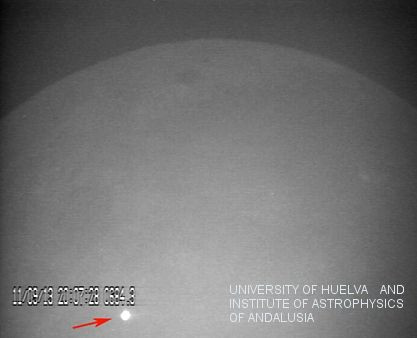880-Pound Meteorite Crashes Into The Moon, Creating A ‘Very Rare And Extraordinary’ Lunar Impact [VIDEO]
Astronomers have captured an incredible lunar impact that occurred last September. A meteorite crashed into the moon, and the event was so bright it was visible on Earth and rivaled the Pole Star. The impact was equivalent to a 15-ton TNT explosion.

The lunar impact occurred on Sept. 11, 2013, and was observed by Jose M. Madiedo, from the University of Huelva in Spain. The meteorite crashed in the Mare Nubium region. The impact was bright enough to be seen from Earth for a few seconds and an afterglow lasted for eight seconds.
According to the statement from the Royal Astronomical Society, the impact flash was the brightest ever recorded. The object that crashed into the moon is believed to have a diameter between 0.6 and 1.4 meters (around 2 to 4.5 feet) and weighed 400 kilograms (882 pounds). The meteorite was traveling at a speed around 61,000 kilometers per hour (37,904 miles per hour) and created a 40 meter (131 foot) crater.
The previous record holder for the brightest lunar impact occurred on March 17, 2013, and was observed by NASA. That earlier meteorite crashed into the Mare Imbrium region of the moon and weighed 40 kilograms (88 pounds) and was traveling at around 56,000 miles per hour
Madiedo and Jose L. Ortiz, from the Institute of Astrophysics of Andalusia, are part of the Moon Impacts Detection and Analysis (MIDAS) system that tracks these types of events. Madiedo said in a statement, “Our telescopes will continue observing the moon as our meteor cameras monitor the Earth's atmosphere. In this way we expect to identify clusters of rocks that could give rise to common impact events on both planetary bodies. We also want to find out where the impacting bodies come from.”
According to Madiedo, observing lunar impacts leads to new insights to the frequency of larger meteorites striking Earth. Based on their research, the team believes meteor-sized objects hit Earth 10 times more frequently than previously believed. Unlike the moon, which has an incredibly thin atmosphere, the Earth has a robust atmosphere that acts as a protective barrier from these larger objects.
NASA has the Lunar Impact Monitoring program that identifies potential impact areas and tracks lunar impacts. According to NASA, the program is used to “identify new streams of space debris that pose a potential threat to the Earth-Moon system.”
The record-breaking lunar impact video can be viewed below. The study was published in the Monthly Notices of the Royal Astronomical Society.
© Copyright IBTimes 2024. All rights reserved.






















